In the construction industry, getting competitive subcontractor bids is critical for general contractors (GCs). Managing Invitations to Bid (ITBs) efficiently can make or break a project’s preconstruction phase.
That’s why many GCs turn to dedicated construction bid management and solicitation software instead of juggling spreadsheets and mass emails. This comparison of SmartBid vs. Downtobid matters because these tools take very different approaches to the same goal: simplifying and improving the bid invitation process for GCs.
SmartBid is a well-established construction bidding platform (now part of ConstructConnect) that many GCs have used for years to organize subcontractor data, send bid invites, and manage documents.
Downtobid, on the other hand, is a modern approach that leverages AI to automate much of the ITB workflow. Both aim to streamline how you invite trade contractors to bid on projects, but they differ in features, user experience, and philosophy.
In this article, we’ll break down what each tool is, explore their features, compare them head-to-head, and share real user feedback. If you’re a GC evaluating bidding software, read on – by the end, you should have a clear sense of which platform fits your team’s needs.
Note: If you want to leverage AI to break down construction plans, extract project scopes, and send personalized bid invites to relevant subs--within minutes, try Downtobid. Our software boasts 30% more response rate from subs and lets you get 100% bid coverage. Claim your free demo here.
What is Downtobid?
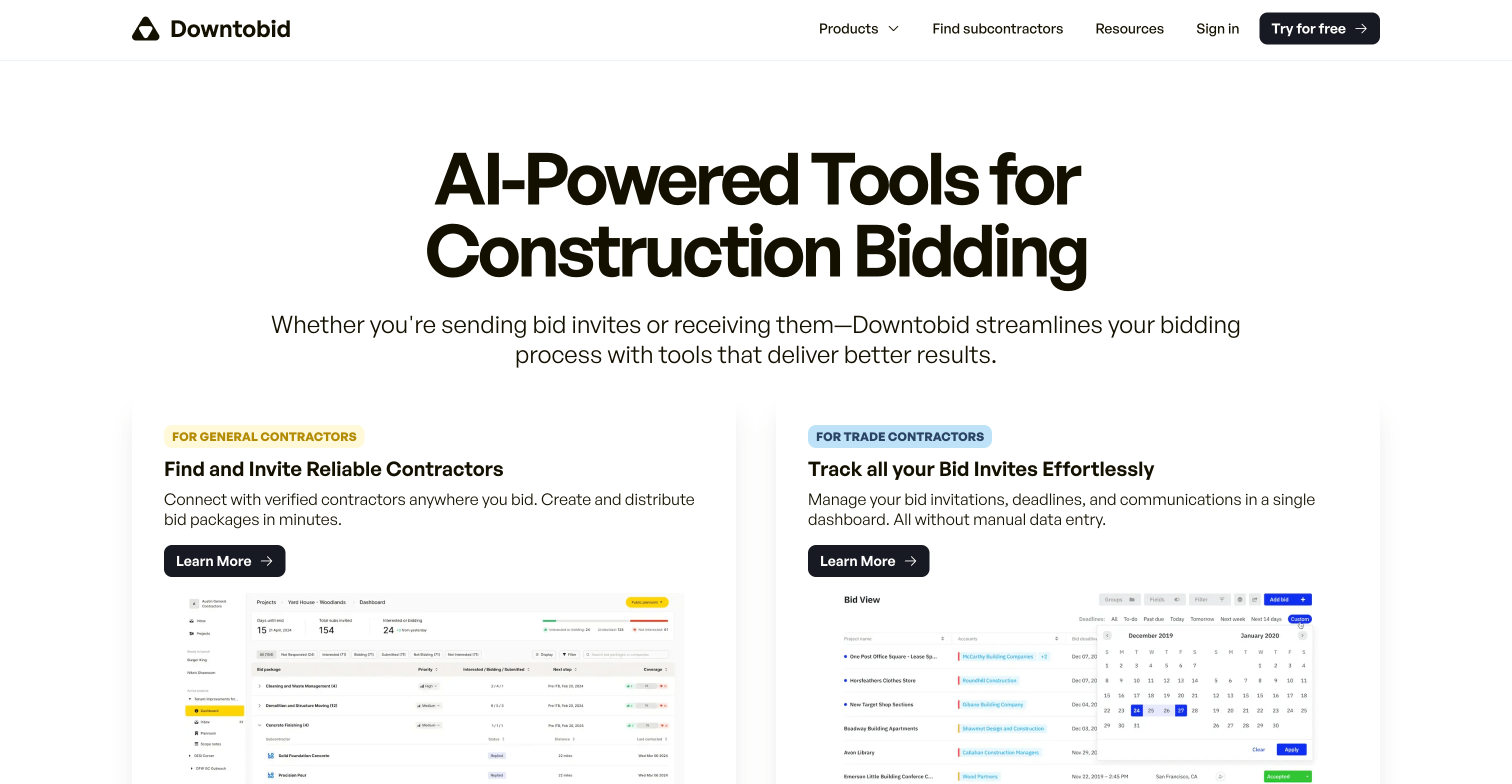
Downtobid is an AI-powered bid invitation platform designed for general contractors to simplify sending out ITBs. In simple terms, Downtobid helps you turn your project plans, specs, and other documents into bid invites with minimal manual effort.
Think of Downtobid as an assistant for your bidding process. You upload your construction drawings and specs, and the system scans them (at a high level) to figure out what trades are needed (e.g. plumbing, electrical, HVAC). It then cross-references its database of subcontractors to recommend ones in the project’s region who do that type of work.
With a few clicks, you can send these trade contractors a tailored invitation to bid – often with project details already filled in by the AI.
We’ll dive into specific features soon, but at a high level, expect Downtobid to handle a lot of the heavy lifting — from the initial page turn to following up with trade contractors — in the bid invitation process.
What is SmartBid?

At its core, SmartBid helps GCs streamline the invitation-to-bid workflow. You can maintain a private database of subcontractors, filter them by trade or location, and send bulk bid invitations for your projects. The platform includes an online plan room for hosting project drawings and specs, so trade contractors can log in to view all the files they need. SmartBid also offers tools for subcontractor prequalification, bid tabulation (comparing bids side by side), and reporting on bid coverage and communication metrics.
It’s known for providing a comprehensive suite of features for preconstruction teams, all in a secure environment.
One thing to note is that SmartBid has been around for a while and is considered a trusted, industry-standard solution for many large GCs. It’s tailored primarily for general contractors’ needs – for example, ensuring your data is private and not shared with competitors, which was a key selling point.
However, because it’s a mature platform, it might not have some of the latest AI-driven bells and whistles. In the next sections, we’ll look at exactly what features SmartBid offers and how it handles the ITB process, before comparing it head-to-head with Downtobid.
Downtobid’s Key Features
Downtobid is tackling pain points across the construction bidding process—from streamlining the understanding of required trades and scopes to automating scope sheet creation to enabling personalized bid invitations aimed at building relationships with subcontractors
Here are some core features for why the Downtobid software is the best construction bid management platform for what you need.
AI Assisted ITB Drafts
The hallmark of Downtobid is automation. When you upload your plans, the system scans them to identify which trades are needed (not in extreme detail, but enough to highlight “You likely need electrical, plumbing, HVAC,” etc.). Then it suggests matchings from its verified database.
- Pros: Saves hours on scoping at a high level, so you don’t forget a key trade
- Cons: Some GCs prefer to do scoping manually; the AI might occasionally miss extremely specialized trades
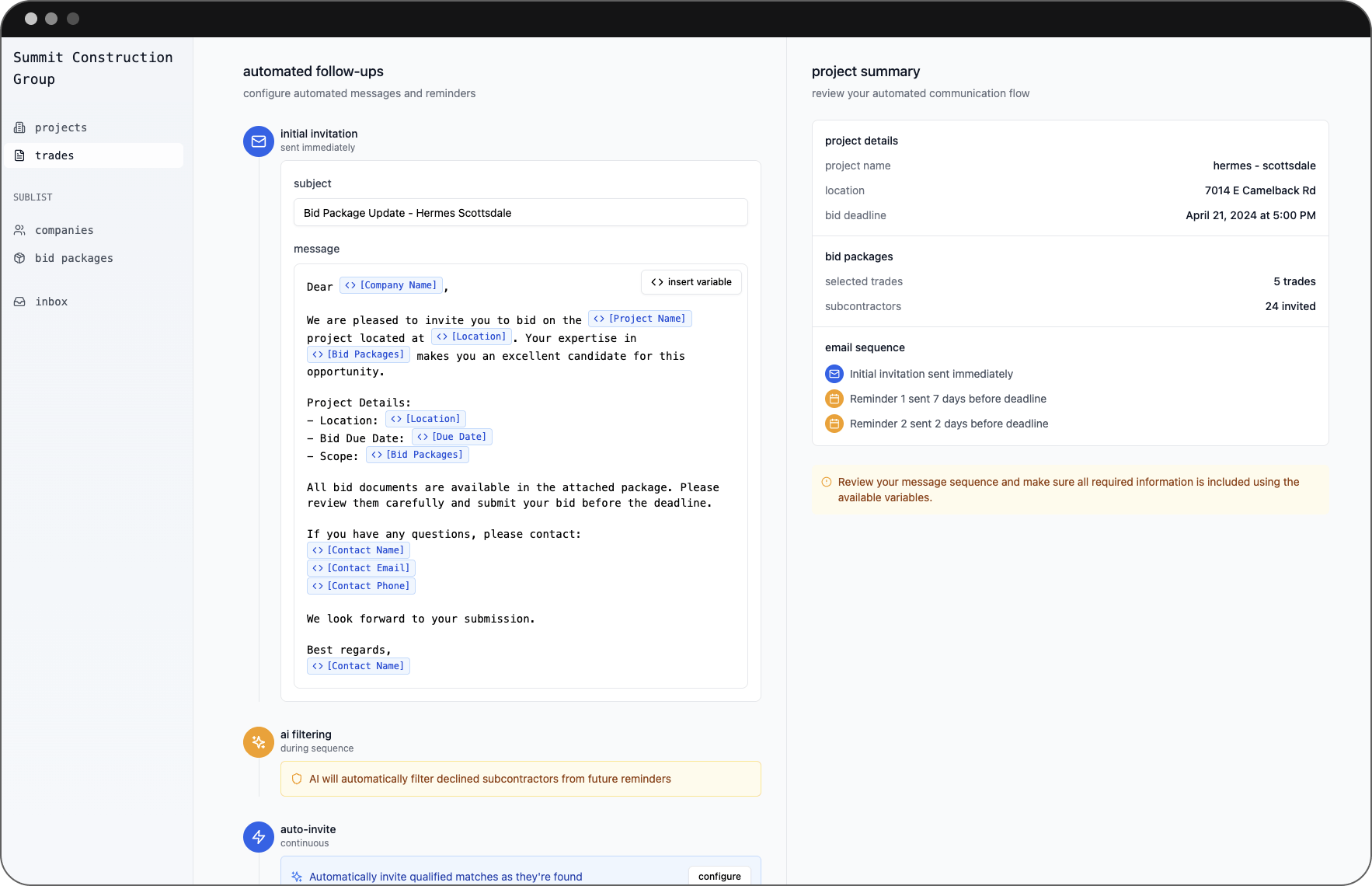
Verified Subcontractor Database
Downtobid’s database is smaller than ConstructConnect’s but focuses on quality. The platform verifies each contact, removing stale emails or defunct companies. For GCs, this means less time wasted sending invites to contacts who won’t respond.
- Pros: You’re reaching active, relevant subs more reliably
- Cons: Might not have the same breadth for rarely used or ultra-niche trades, so you may add those manually
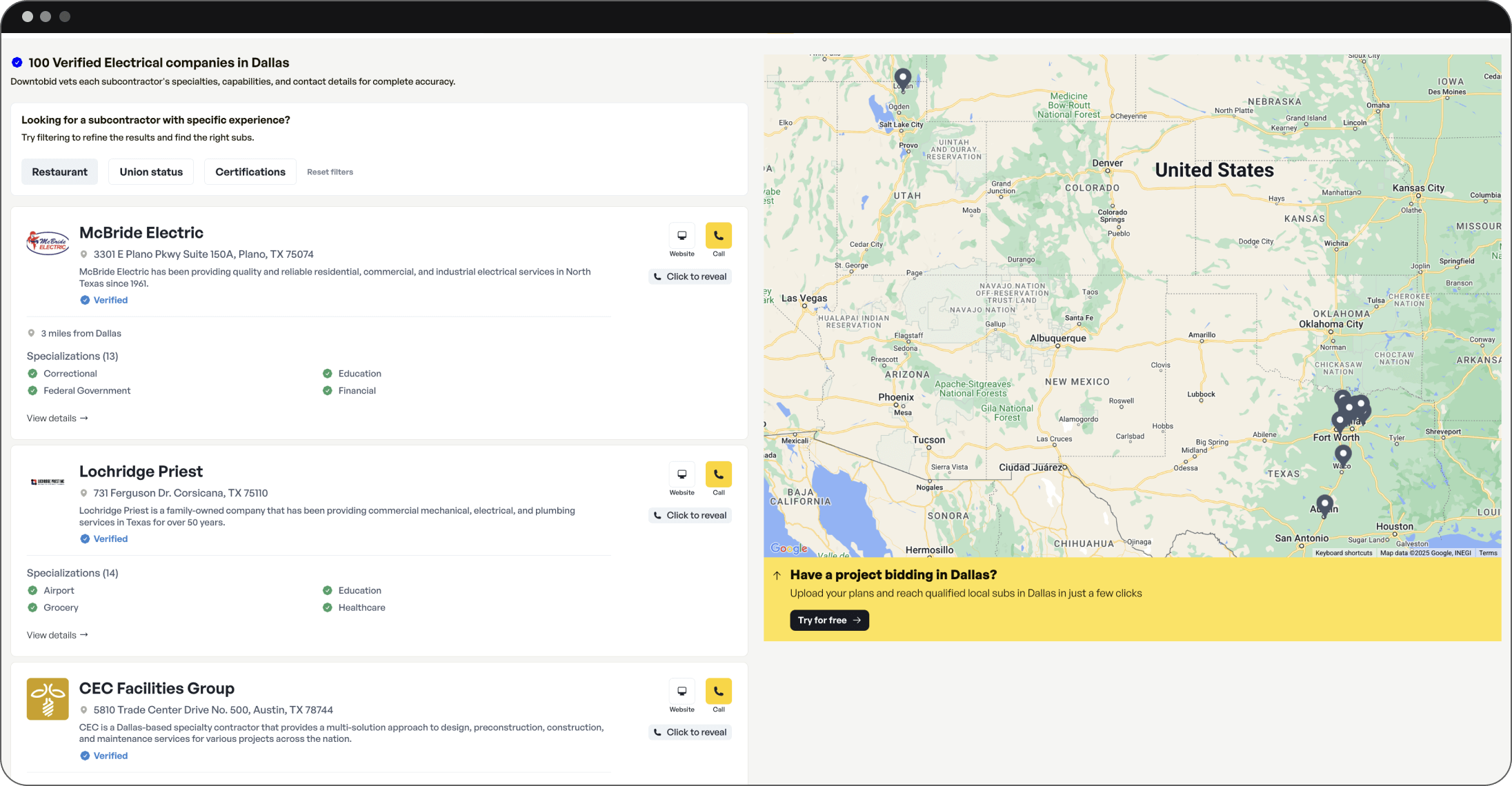
Sub-Friendly Planroom (No Logins)
Downtobid organizes the uploaded docs automatically (Plans, Specs, Photos, etc.) and indexes them so each page is labeled. Subcontractors can open the planroom without creating an account, which drastically reduces friction.
- Pros: Less hassle for subs, typically boosting engagement
- Cons: GCs wanting advanced permission controls might not find them
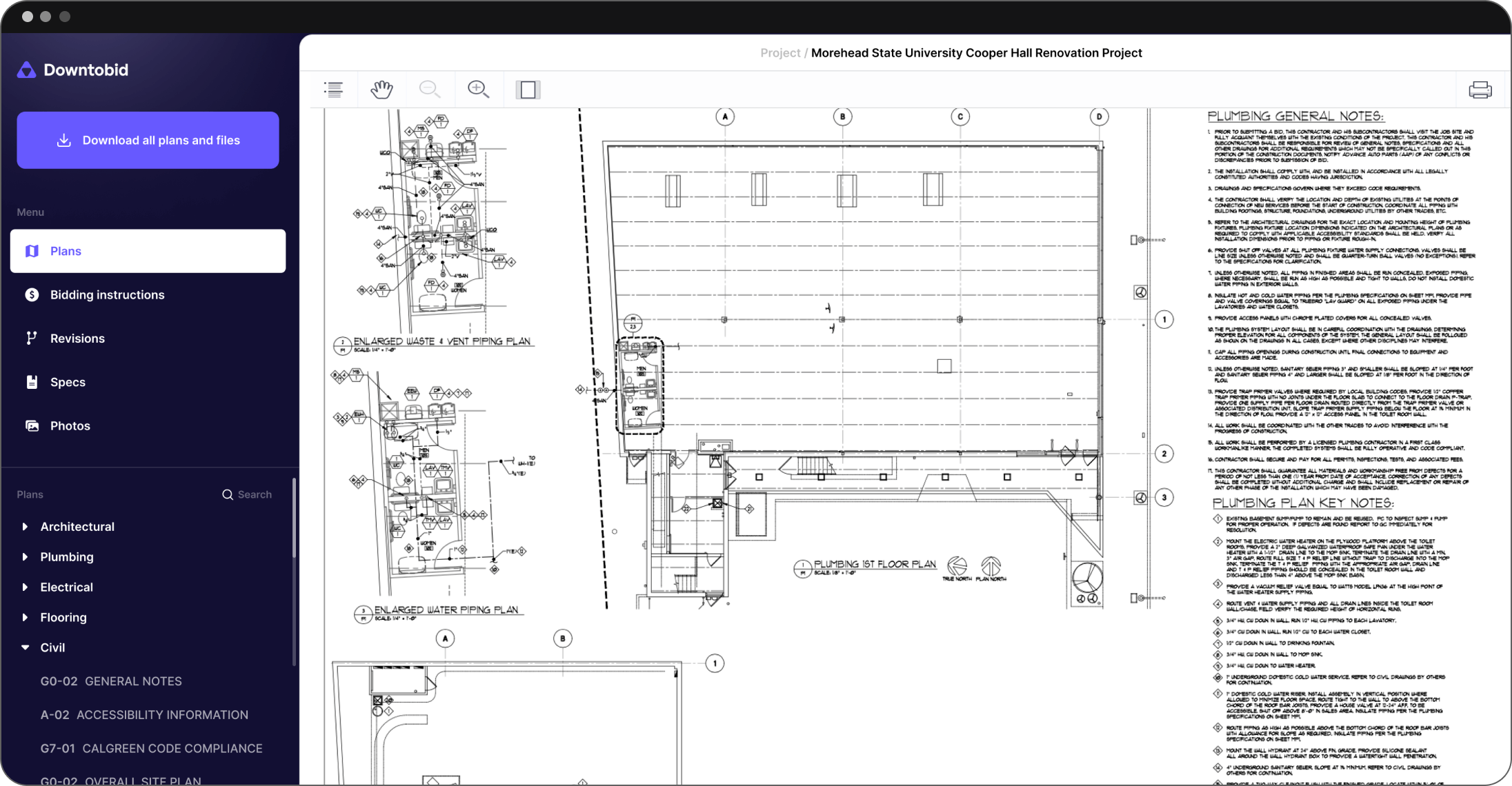
Automated Follow-ups & Real-Time Coverage
After sending invites, Downtobid watches who’s opened the email or downloaded files. If a sub hasn’t responded, the system sends polite reminder emails at intervals. GCs see a live coverage board showing “Bidding,” “Not Bidding,” or “No Response.”
- Pros: Freed from phone-tag with every sub; higher chance of timely replies
- Cons: Some GCs still want personal calls for key subs; advanced reporting might be limited compared to older enterprise tools.
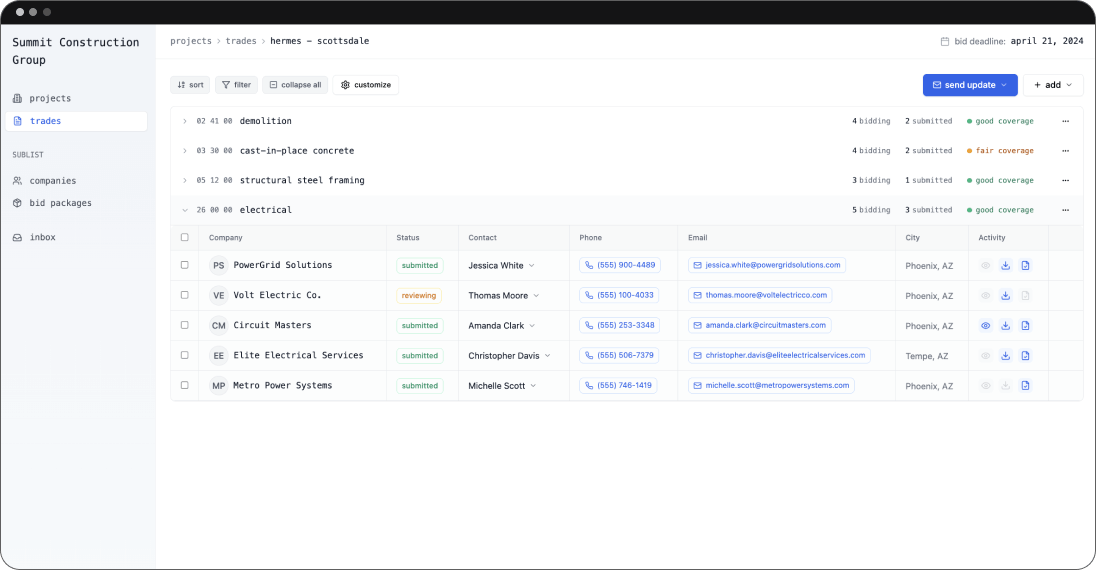
Integrations & Ongoing Development
Downtobid’s approach is to minimize external steps for bidding alone. It’s building out integrations with major PM tools. Because it’s newer, it might not yet have every integration that SmartBid does, but it updates frequently, driven by user feedback.
- Pros: AI plus integrated plan management = fewer apps needed
- Cons: If you rely on legacy software or highly specialized ERP, you might see fewer direct sync options
SmartBid’s Core Features
SmartBid streamlines the management of bid project data, construction bid docs, and communications with subcontractors.
This software is really handy during the early stages of a building project. It's great for both folks who handle big commercial jobs and those who work on residential houses. Plus, general contractors and subcontractors get a cool benefit: they can find and bid on public project jobs all over the country through something called the ConstructConnect Network Public Plan Room. This opens up a whole bunch of opportunities, no matter if they're looking to work on big buildings or someone's home. Here are the core features of Smartbid.
ITB Management
SmartBid is built around managing Invitations to Bid at scale. You can create a project, upload documents, and select which subcontractors (from your private list or ConstructConnect’s network) to invite. A single dashboard tracks who opened the invite, who’s declined, and who hasn’t responded.
While you can customize the invite message, many GCs end up sending generic blasts. Subs log in to view documents or mark their intent. In theory, this simplifies the process compared to emailing zip files. However, there’s limited personalization per sub. If you want a more targeted message, you’ll have to draft it outside or manually adjust each email.\
Why GCs Like It
- Straightforward way to manage large-scale ITBs
- Integrations with other industry tools (Procore, Autodesk)
- Ties into a massive subcontractor database for broader outreach
Trade-offs
- Sub-level personalization is minimal. You do the scoping and selection.
- Follow-up often remains a manual chore.
Subcontractor Network
One of SmartBid’s biggest selling points is ConstructConnect’s network. GCs can potentially access a vast pool of trade contractors across multiple states. If you’re expanding geographically or tackling specialized trades, this wide net can help.
- Pros: Potential to find niche or out-of-area subs quickly
- Cons: Some contact info might be outdated; the bigger the network, the more duplicates or stale leads you may encounter.
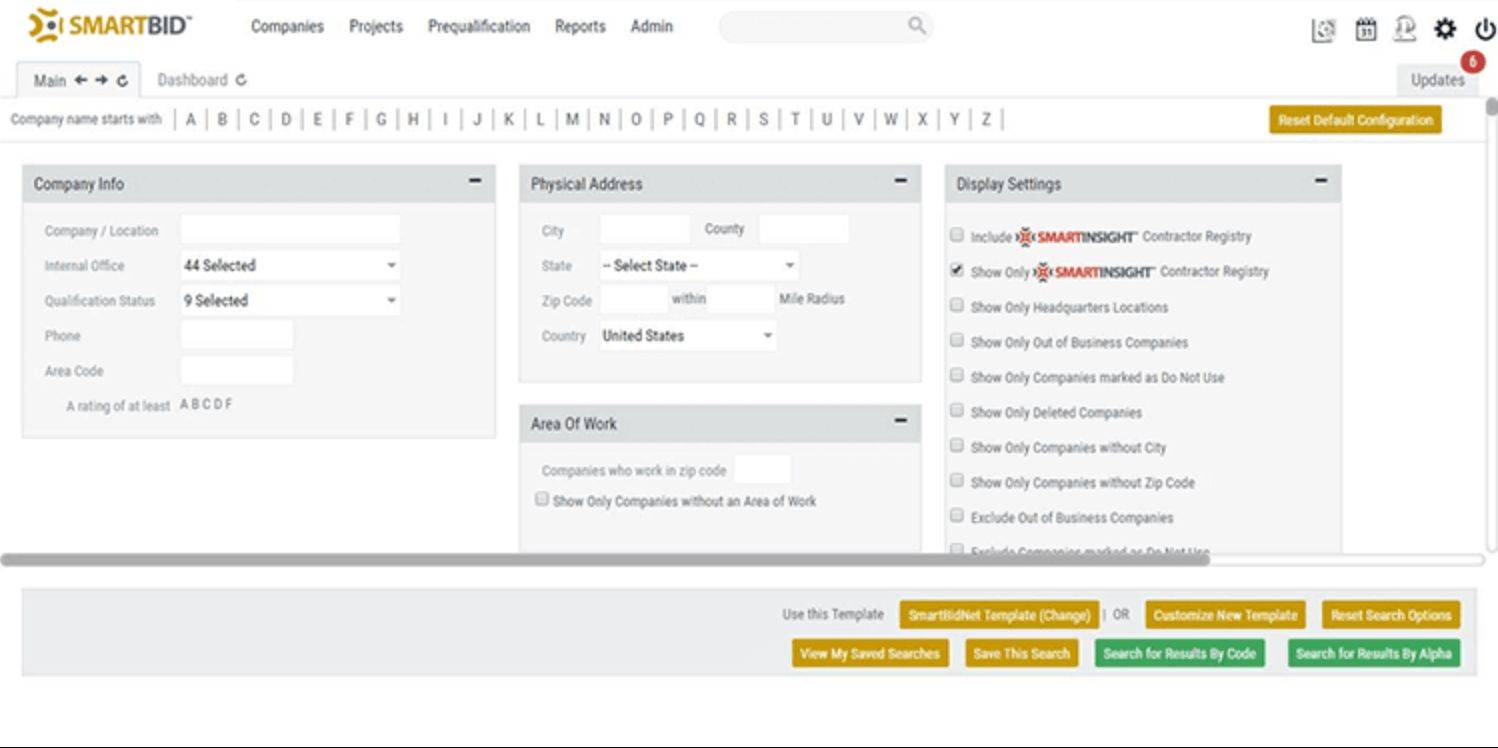
Planroom & Document Management
SmartBid’s planroom allows GCs to store all drawings and specs in one spot. Subcontractors log in to view or download them. You can upload revised versions as addenda and track who’s downloaded the latest files.
- Pros: Keeps documents off your email; unlimited file storage
- Cons: Subs must log in to see files, which can deter those who don’t want another account. GCs need to maintain a good folder structure or risk confusing subs.
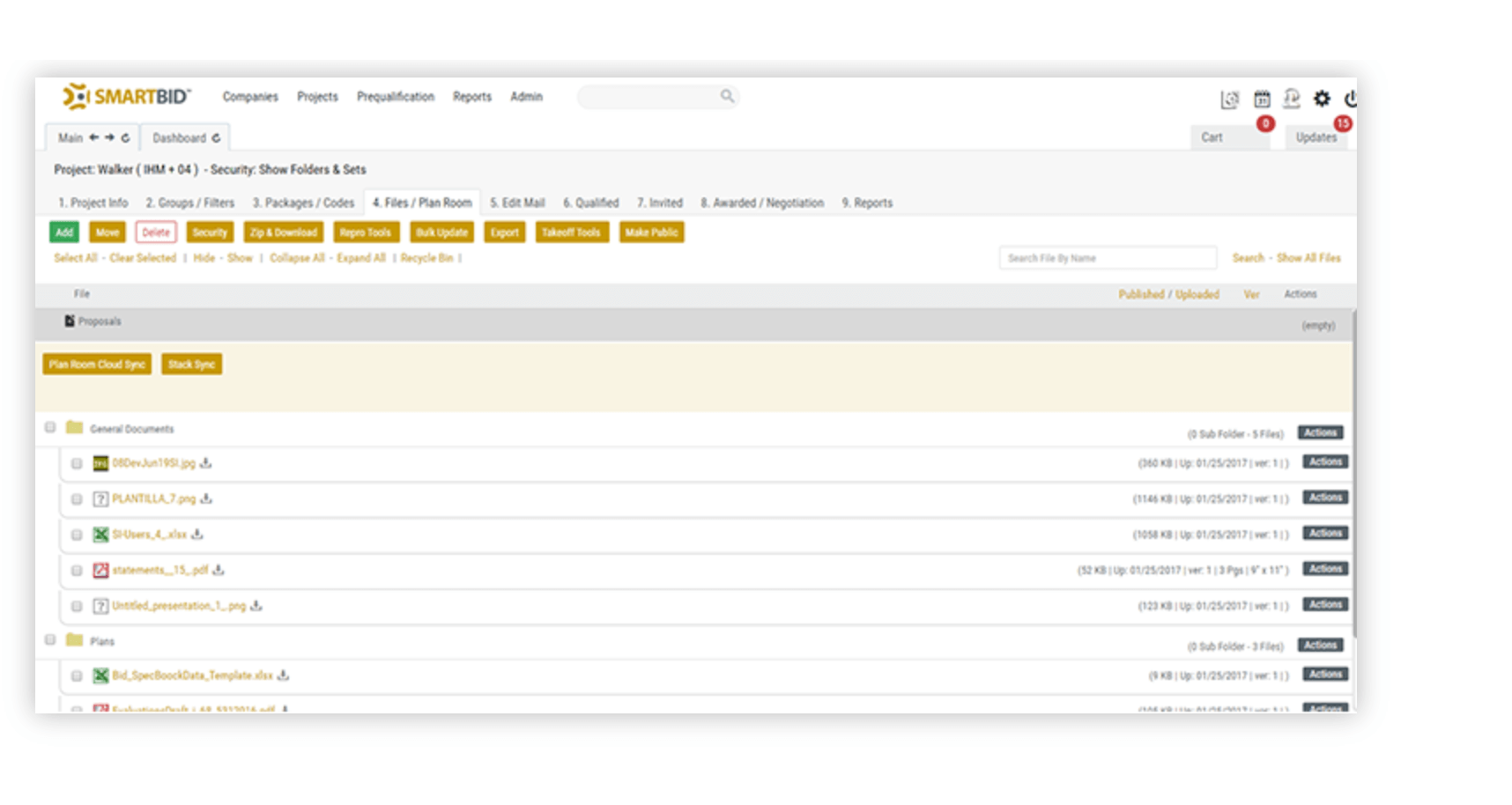
Bid Tracking & Follow-ups
SmartBid displays basic coverage data—who’s bidding, who’s not, who’s “undecided.” GCs can generate quick reports on sub engagements. For deeper follow-ups, though, you’ll typically rely on phone calls or separate emails.
- Pros: Clear snapshot of coverage per trade
- Cons: Minimal automation for reminders or repeated nudges
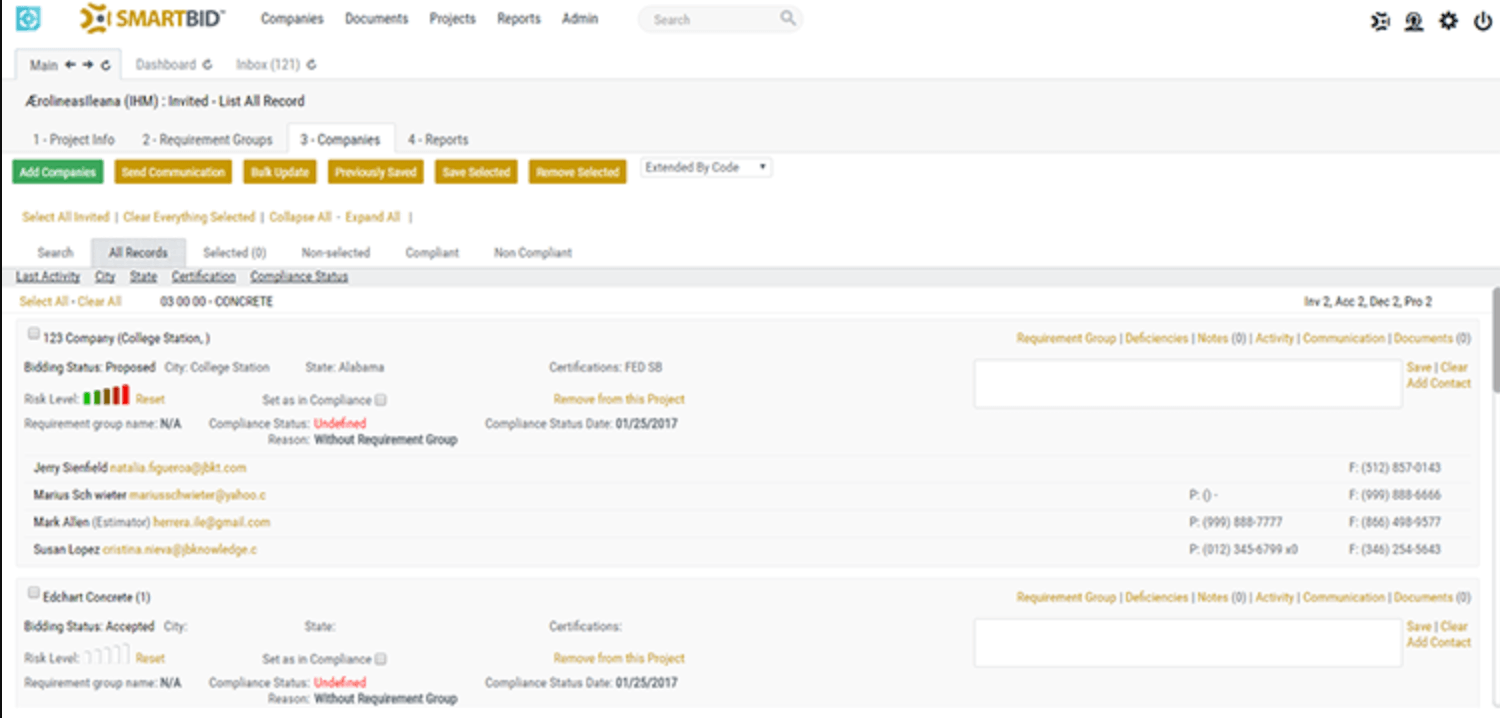
Integrations & Workflow Automation
Because SmartBid has been around for years, it integrates with many major platforms—Procore, Autodesk, STACK, and so forth. This is convenient for GCs wanting a single ecosystem, pushing or pulling project data as you move from preconstruction to execution.
- Pros: Fits neatly in a big-tech stack
- Cons: No AI for scope identification or personalized invites
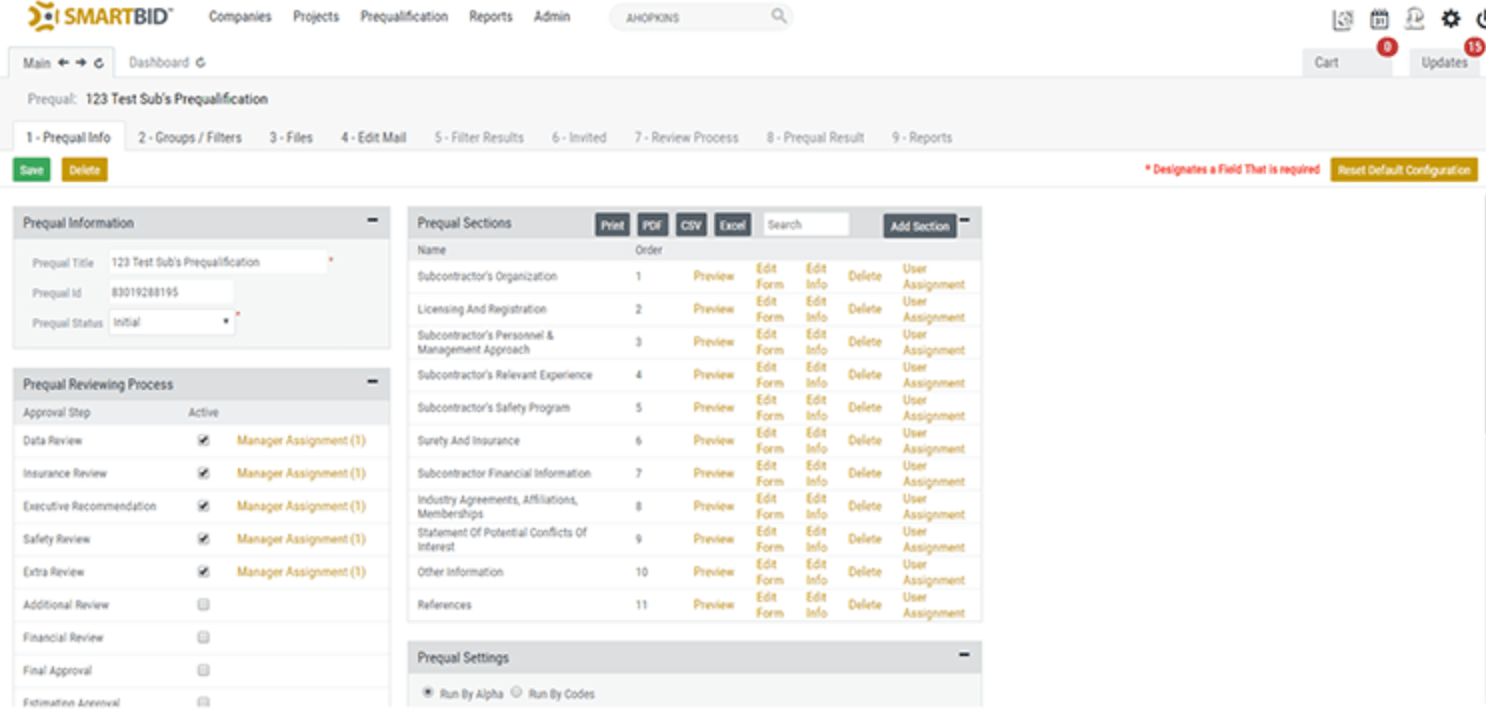
Head-to-Head Feature Comparison
Now that we’ve detailed what each platform offers, let’s compare SmartBid and Downtobid directly in the key areas. Here’s how they stack up against each other and which platform tends to excel in each category:
ITB Management: Traditional vs. Automated
SmartBid: Provides a reliable way to send mass invitations and track responses. It’s excellent for organizing large invite lists and has proven templates and emailing systems. However, it relies on the GC to set up everything – from selecting trade contractors to writing the message – and trade contractors often receive a generic-looking invite.
There’s no built-in intelligence to refine or personalize the outreach; GCs must do follow-ups largely on their own.
Downtobid: Excels with automation and personalization. The platform essentially prepares the invites for you after analyzing the project. Each invitation is customized to the recipient, which significantly improves the chances of the sub paying attention. Downtobid also automates follow-up emails to gently push for a response. This means less manual chasing for your team and typically a higher response rate.
Which is better? For efficiency and response rates, Downtobid has the edge. It simplifies the GC’s workload and engages trade contractors with targeted messages, achieving roughly an increase of 34% bid participation through personalized outreach.. SmartBid is robust, but it’s more of a traditional tool – you get out what you put in. GCs with established processes might find SmartBid sufficient for sending invites, but those looking to save time and get more bids back will appreciate Downtobid’s automated ITB workflow.
Subcontractor Network: Quantity vs. Quality
SmartBid: Backed by ConstructConnect’s enormous subcontractor network, SmartBid gives access to an extensive list of trade contractors nationwide. If you need to reach a lot of potential bidders or are working in unfamiliar territories, SmartBid’s database can be a goldmine.
The flip side is that such a large network can contain outdated info or uninterested firms – it’s on you to vet and filter. In practice, many GCs end up inviting the same trusted trade contractors repeatedly and may use the wider network only when needed.
Downtobid: Takes a curated approach. Its network is continuously verified and kept accurate. It might have fewer total contacts than ConstructConnect, but the trade contractors you find on Downtobid are more likely to be active and a good match.

The AI recommendations further narrow it down to relevant local subcontractors for your specific project Essentially, Downtobid favors quality and relevance over quantity. The network is also growing, and because Downtobid is a newer platform, trade contractors who join are often those open to modern bidding processes – potentially making them more responsive.
Which is better? It depends on your needs:
If reach and variety are your priority (for example, you want to blast an ITB to 200 plumbers across the state to see who bites), SmartBid’s massive network wins.
If precision and up-to-date contacts matter more (for example, you’d rather invite 10 plumbers who are definitely in the area and qualified), Downtobid’s curated network is superior. It saves you from chasing dead leads.
For many GCs, the quality approach actually yields better results – inviting 10 solid trade contractors is often better than 100 random ones. But if you truly need to maximize the pool of bidders, SmartBid offers a broader directory to draw from.
Planroom & Document Management: Feature-Rich vs. User-Friendly
SmartBid: Offers a feature-rich planroom with unlimited file storage and granular permission controls. GCs can upload all project documents and manage who sees what, which is great for thoroughness as well as document management.
However, SmartBid’s planroom can become cumbersome if not organized well, since files aren’t automatically sorted by category. Subcontractors may need to create an account to fully interact and often have to download large file sets to find their sheets. In essence, SmartBid gives you the tools to share documents, but the onus is on the GC to ensure the planroom is navigable.
Downtobid: Emphasizes user-friendliness and does the organizing for you. Documents are sorted into logical categories and every page is indexed so trade contractors can quickly find what they need. No login is required for trade contractors to access files – a simple, clickable link opens the planroom. New revisions or addenda are updated in real time, keeping everyone in sync.
The Downtobid planroom might not have as many bells and whistles for permission settings, but it’s straightforward and efficient. It was designed to minimize the time trade contractors spend figuring out drawings.
Which is better? Downtobid wins for subcontractor experience and convenience, which ultimately benefits GCs by making trade contractors more willing to engage. trade contractors have explicitly expressed frustration with disorganized or cumbersome planrooms on older platforms and Downtobid directly addresses that.
Bid Tracking & Follow-ups: Monitoring vs. Maximizing
SmartBid: Focuses on monitoring and reporting. It will tell you who has responded and who hasn’t, and it allows you to send messages or reminders, but it doesn’t proactively do much beyond sending the initial invite. GCs using SmartBid often resort to traditional follow-up methods (emails, phone calls outside the system) when trade contractors don’t respond.
Downtobid: Aims to maximize actual bid responses, not just track them. It automates follow-up with personalized reminders and it designs the whole invite process to avoid the spam trap that many ITBs fall into.. By making each email relevant and following up strategically, Downtobid significantly increases the likelihood trade contractors will reply or at least give a clear “no” so you’re not left hanging.
Essentially, Downtobid doesn’t just track your bid coverage – it actively improves your bid coverage by coaching trade contractors to participate. It’s like having a virtual bid coordinator who keeps poking the trade contractors for you (politely)
Which is better? Downtobid has a clear advantage in driving follow-ups and responses. If your main pain point is trade contractors not replying, Downtobid directly tackles that by design. SmartBid gives you the tools to manage the process, but you are still the one driving it. A Reddit user pointed out that most systems require ~80% phone follow-ups anyway – Downtobid is trying to lower that percentage by doing a chunk of it for you.
Integrations & Workflow: Established Ecosystem vs. Built-in Automation
SmartBid: Being a long-standing solution, SmartBid integrates with many industry tools. If your company uses Procore, Oracle, AutoDesk, etc., SmartBid likely has a way to plug in. This can make data handoff and multi-system workflows much easier – for instance, exporting your final subcontractor list to your project management software.
In short, SmartBid is part of a broader preconstruction and construction tech ecosystem, which is a big plus for firms with complex tech stacks.
Downtobid: Is newer and thus has a more limited, though growing, set of integrations. It covers a lot in-house (plan reading, email automation, etc.), reducing the need for some external tools.
That said, many GCs find that Downtobid can operate as a mostly standalone solution for the bidding phase. The workflow it provides is quite comprehensive from start (plans) to finish (bids received).
Which is better? If you require seamless integration into a larger enterprise workflow, SmartBid currently has the upper hand. It’s tried-and-tested in plugging into other software, which can be crucial for big companies. However, for small to mid-sized teams or those who value automation over integration, Downtobid’s built-in features can replace the need for multiple tools.
As of now, SmartBid is the safer bet for integration needs, whereas Downtobid shines when you prioritize an all-in-one automated workflow for bidding.
SmartBid vs Downtobid: What Reddit Users Are Saying
Hearing from actual users can provide insight into these platforms. We pulled from a popular a popular Reddit thread to showcase some estimators firsthand experiences.
Here are some candid takeaways from those conversations:
“All the old tools feel the same” – One user, after trialing multiple bid invitation softwares (PlanHub, BidMail, Pantera, etc.), said “I basically couldn't find a difference in any of them”, referring to many legacy platforms having similar shortcomings.
This individual ended up choosing Downtobid, noting they were impressed by the fresh approach. “I found a startup called Downtobid… I highly recommend their team” the user wrote, mentioning they became a beta tester and liked that the product was actively being developed.
SmartBid users acknowledge its ubiquity (and quirks): On r/estimators, one commenter shared, “We use SmartBid. Big database of trade contractors. Easy to send out plans and amendments.”
This highlights two of SmartBid’s strong points: its large subcontractor list and the straightforward process of distributing plans. However, others had more mixed feelings. Another estimator said, “I’ve used SmartBid and BidMail – they are pretty much identical. BidMail is more user friendly.”
It’s sometimes seen as a bit old-school; for instance, a subcontractor-side user commented that invites via BuildingConnected were preferable and that “SmartBid sucks”, lumping SmartBid and some others as generally similar in trade contractors’ eyes.
Subcontractor perspective – less spam, more personal: Subcontractors often complain about the volume of generic ITB emails they get. In one discussion, a subcontractor noted they receive 30-50 invites a month, mostly generic, and admitted, “If someone reaches out directly, that ups the chances I provide a bid from about 10% to 90%.”
This underscores why Downtobid’s personalized approach could be a game-changer – it attempts to simulate that “reach out directly” feeling at scale. The spam issue is real; trade contractors mention that being bombarded with impersonal invites leads them to ignore many.
Early adopters of Downtobid are enthusiastic: The general tone from users who have tried Downtobid is positive. For example, a Reddit user in late 2024 mentioned, “downtobid.com is what we are using. [It’s] cheaper and has built-in AI...”
Cost was a factor here – they explicitly noted Downtobid being a more affordable solution. Another user chimed in that they chose Downtobid because it was the only one actively improving and that even the founder was accessible in the community.
SmartBid still has its proponents (especially in larger firms): Some users, particularly those at bigger companies, stick with SmartBid because it’s a known quantity and integrates with their systems. One commenter compared SmartBid vs BuildingConnected and said, “In my opinion, SmartBid is superior, but BuildingConnected is easier to train casual users on.”
Of course, every company’s experience can differ, but it’s telling that numerous estimators on Reddit have independently brought up Downtobid as a promising tool, whereas SmartBid tends to be mentioned as the incumbent that “we’ve been using for years.” Both perspectives have merit depending on what you value.
Track bid coverage all in one place
Our philosophy around coverage is simply: make everything easy for the subcontractor as possible. In today's market – commercial subcontractors are being inundated with bid invites. Most of them don't even have a construction bid tracking spreadsheet to organize their bids.
During the solicitation process, we make our invites personalized and relevant. We include specifics like the square footage and project type directly in the email subject line—not just “Bid Invite” and the project name. This makes it easier for a subcontractor to open your email.
When subcontractors review plans, we break things out by sheet so they can easily navigate to their scope. While every sub should ultimately examine all pages in case of additional scope, trade-specific contractors need to quickly find their main sections—like a doors sub knowing where the door schedule is. We help enable that.
Finally, we opt not to have three bidding intent buttons that research shows get low engagement. Since our emails are regular emails, the sub simply responds directly, letting you focus on relationship building versus managing bid status fields.
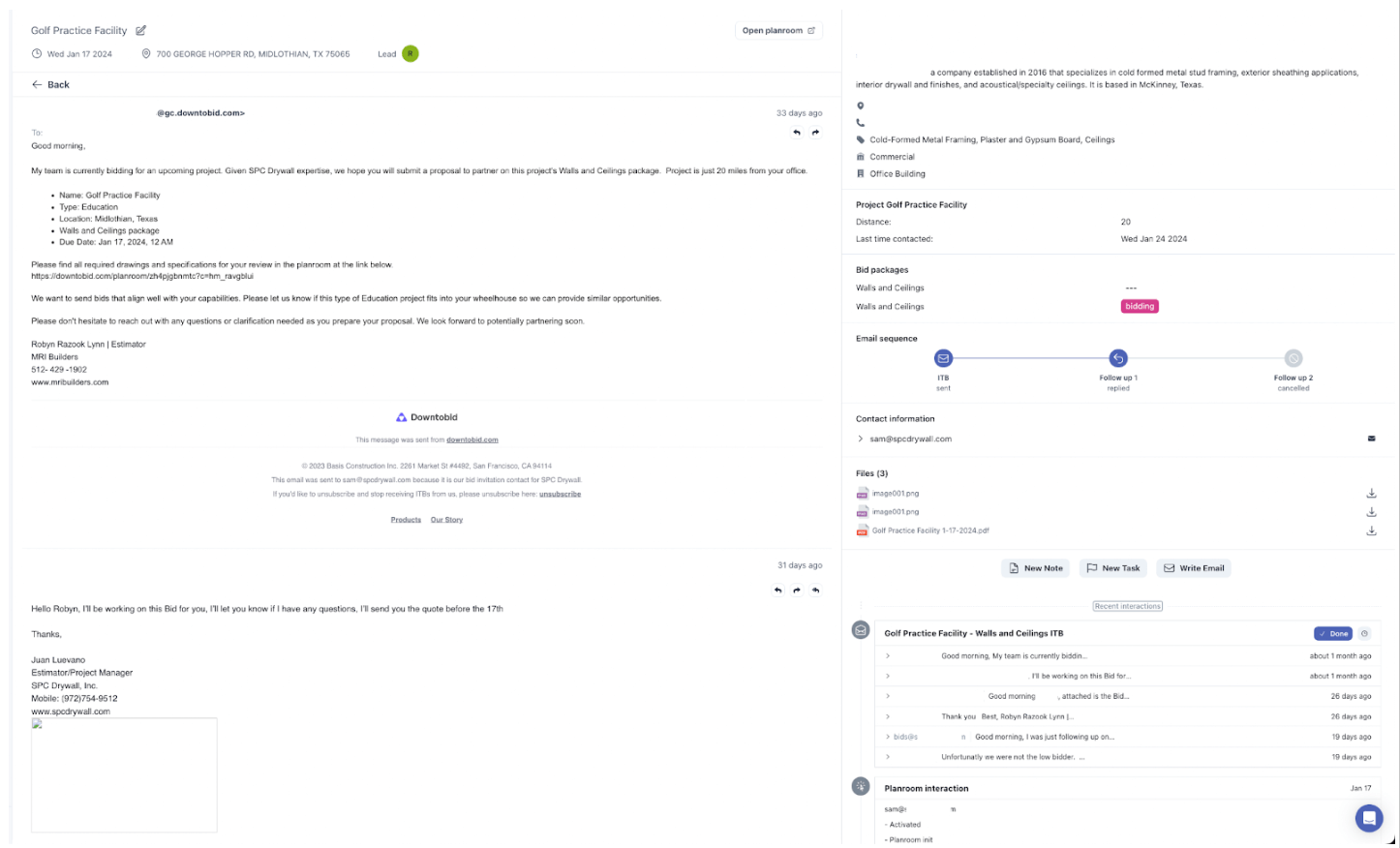
The results? For one project – generated over 30+ bids in an entirely new market.
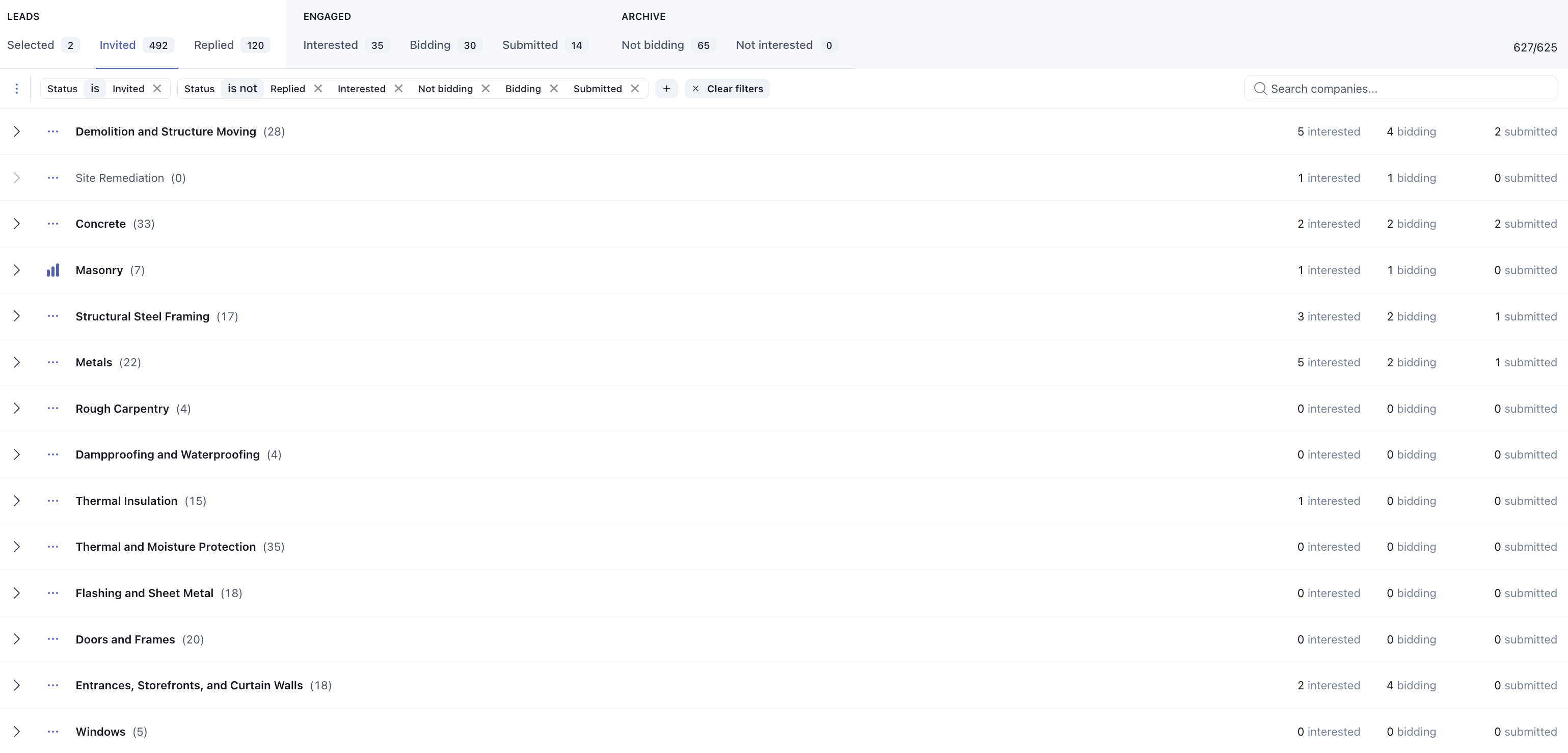
If you're curious, you can click here to get started for free.
Why Downtobid Stands Out
We set ourself apart in the online bidding platforms through our unique blend of AI-driven efficiency and customization. The AI quickly identifies bid packages from construction plans, drastically reducing the time and effort traditionally required in bid preparation.
Our software creates custom subcontractor invite lists automatically, improving the quality and saves you time on the construction bidding process. After you submit your construction plans, our software automatically generates bid invitations to general contractors worldwide.
Our users have reported significant time savings and increased efficiency in managing bid invitations, with some noting a reduction in bid preparation time by up to 30%. This efficiency translates into quicker project turnaround and cost savings, directly benefiting project managers and contractors.
We have scalable solutions cater to a wide range of project sizes, making it an ideal tool for both small local projects and larger, more complex construction projects.
Cost Of Downtobid
You can begin using our software 125$ for the basic plan (up to 3 users) or $500 a month for the Pro (up to 10 users). We understand most General Contractors already use other software, so we wanted to make trying Downtobid completely risk-free.
For those looking to expand their scope, add more users and handle more projects, we offer the Pro Plan.
Read our full features comparison of SmartBid vs Building Connected and Downtobid.
Key Features and Functionality:
- Streamlined Bid Management: SmartBid excels in organizing and managing bid project data, providing general contractors with a comprehensive view of all bidding activities.
- Document and Communication Control: It allows efficient sharing and control of documents. This includes features like document sharing, plan distribution & viewing, and collaboration & approvals, ensuring all parties are on the same page. It allows multiple estimators to work on the same project in a well-organized, properly restricted system, to reduce errors and improve collaboration.
- Subcontractor Communications: SmartBid simplifies interactions with subcontractors. It supports seamless communication, allowing for effective exchange of information and invitations to bid.
- Integration Capabilities: The platform integrates with various other tools like Procore, Autodesk BIM 360, and Dropbox
- Mobile Accessibility: The mobile app functionality ensures that users can access the system from the field, bringing flexibility and real-time management to the bidding process.
- User Experience: SmartBid is rated highly for its user-friendly interface. It is praised for its ability to streamline the bidding process, making it more efficient and less time-consuming. Users have noted the ease of setting up jobs, managing solicitations, and the convenience of the mobile app.
Pros:
- SmartBid's document sharing, plan and bid coverage distribution features are particularly well-received.
- The platform's user interface is considered user-friendly, enhancing the overall experience.
- The ability to integrate with other major software platforms is a big advantage.
Cons:
- Some users have suggested improvements in the graphical interface to enhance usability.
- The reporting functions have been noted as an area needing improvement.
- Limitations in file size upload and the need for more automated operations have been mentioned as areas for improvement.
Cost of Smartbid
SmartBid's pricing often varies based on factors like the number of users, the scale of the project, and the specific features required.
Detailed Comparison Summary
Downtobid, and Smartbid each cater to different markets with specialized features. General contractors favor Smartbid for its comprehensive bid management and communication tools, ideal for both commercial and residential construction.
Downtobid differentiates itself with AI-driven technology, excelling in quickly transforming construction plans into bid invites.
Its user-friendly interface and flexible pricing, including a free option, appeal to many construction projects. While Smartbid is strong in its niches, Downtobid's AI capabilities and easy process make it a great choice for construction bidding.
Try Downtobid today at no cost here.
Which Platform is Best for Your Team?
Choosing between SmartBid and Downtobid ultimately comes down to your general contracting team’s specific needs, budget, and willingness to adopt new workflows. Here’s a final breakdown to help you decide:
Choose SmartBid if: you are a larger GC or established firm that values a proven system with extensive integrations and don’t mind a bit of a learning curve. SmartBid is ideal if you already use other ConstructConnect products or Procore, since it will fit right into that ecosystem.
Choose Downtobid if: you are a small to mid-sized GC, or simply a team that wants to save time and get better bidding results through automation. Downtobid shines for teams that lack a big support staff to handle invites – the AI becomes your extra estimator assistant. If you’ve ever been frustrated with chasing trade contractors or felt that your current bid tool is clunky, Downtobid is a breath of fresh air.
If you’re a GC tired of doing the same manual follow-ups and want to try a new approach, give Downtobid a shot (you can start for free to gauge its impact). If you’re generally happy with your bid process but need a reliable platform to centralize it, SmartBid is a time-tested choice with a lot of industry support.
The construction tech space is evolving, and Downtobid represents the next generation with AI-driven efficiency, while SmartBid represents the solid foundation that has served GCs for the past decade-plus. Evaluate your current pain points – the right platform for you will be the one that alleviates those pains the most. Whether it’s SmartBid or Downtobid, the end goal is the same: better bid management, less headache, and more successful projects.
Good luck and happy bidding!